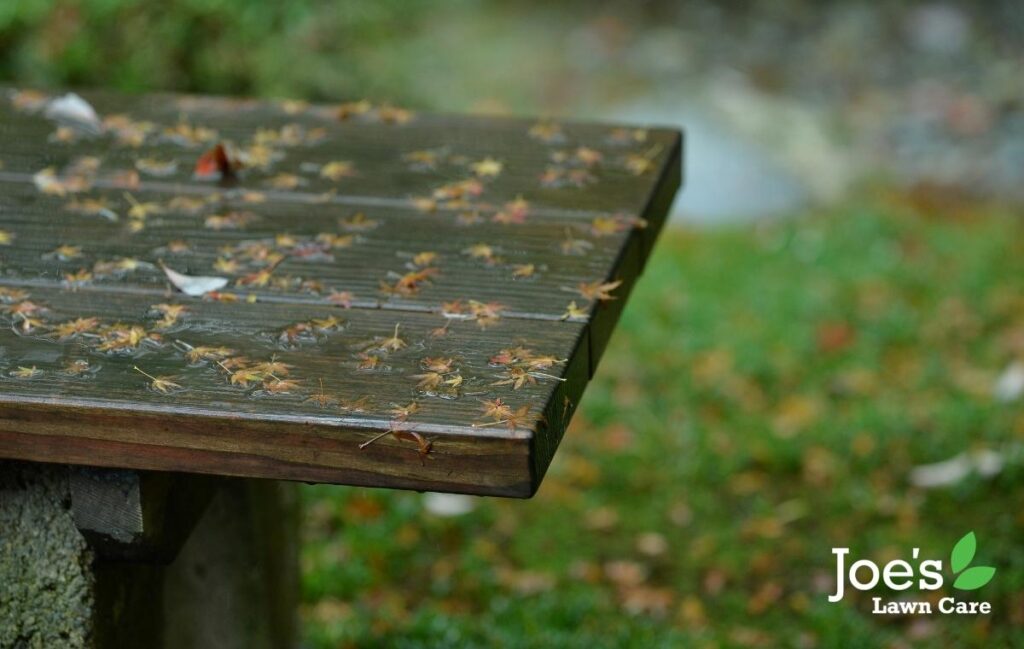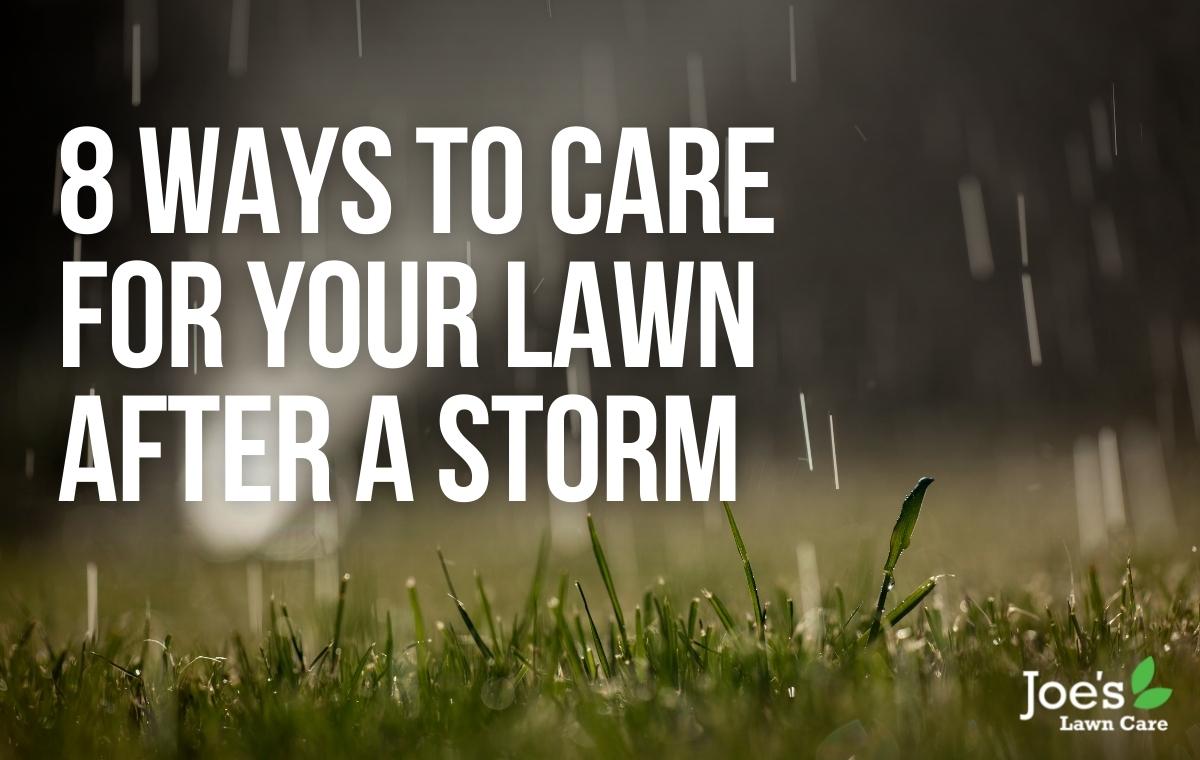8 Ways To Care For Your Lawn After A Storm
There are few things more serene than sitting (somewhere warm and comfortable) and watching a storm roll in. That is until that storm leaves your lawn more bedraggled than a teenager at the end of Fresher’s Week. That’s when the serenity of a distant storm is swapped for the headache of a major clean up job. Something that Storm Dudley, Eunice and Franklin all left us with: a major clean up job.
Trees were toppled, sheds were sent flying. The roof of everyone’s favourite London dome was ripped off and lawns were left looking more than just a little dishevelled.
From being covered in a long list of debris to becoming heavily waterlogged to suffering from hard-and-fast soil erosion. When a storm rolls into town, your lawn can take a pretty big beating. The question is: how do you keep your lawn looking lush, green and healthy after a storm?
Well, to help you out, we’ve pulled together 8 top tips to make sure your lawn gets all the post-storm care it needs to bounce back to its former glory. Ready? Let’s do this:

Top Tip #1: Don’t Mow Your Lawn
Most storms are a nasty combination of wind and rain, and there’s nothing worse than mowing wet grass. So, make sure your mower stays safely locked away in your shed. From getting an uneven cut to creating the perfect environment for fungal diseases to causing some unnecessary soil compaction, mowing a wet lawn is a terrible idea. Instead, wait until your lawn has almost-entirely dried out and then mow it, making sure your mower deck is set to the highest setting so that you give your lawn every chance to bounce back as quickly as possible.
Top Tip #2: Keep Off Your Grass
Unless there is a situation on the other side of your lawn that needs urgent attention, try and keep off your wet grass until it has dried up a little. Why? Because walking on wet grass is one of the worst things you can do to your lawn. Not only will you cause unwanted soil compaction (urgh), you’ll also put your grass blades at risk of serious damage. The kind of damage that could quickly lead to fusarium (and other fungal diseases) developing. As a general rule of thumb, let enough rainwater drain away so that you’re not leaving footprints behind when walking across your turf.
Top Tip #3: Study Your Lawn
After a heavy storm, one of the best things you can do is whip out your notepad. Draw a rough birds-eye-view picture of your lawn and then make note of any area that is showing poor drainage. Once you’ve identified these areas, you’ll be able to storm-proof your lawn before the next one rolls in. For example, fill in any dips so that your lawn is either level or slopes away. Then opt for a fracture-tine aeration treatment to improve the drainage of your garden.
Top Tip #4: Aeration For The Win
Whether you’re looking to limit the damage of any future storms or help your lawn recover after a pretty heavy one, aerating your lawn has so many benefits. Not only will it improve drainage after a solid amount of rainfall but it will also help establish a healthier lawn. A lawn that will be able to survive and thrive a lot more successfully no matter what threatens it next. That’s the secret to good lawn care: it’s about creating a lawn that can look after itself. So grab a garden fork – or better yet, an aerator. This will help improve your lawn’s drainage abilities, while also helping more air and nutrients get down to the deepest parts of your root system.
Top Tip #5: Clear Up Any Silt
Whether it was the wind’s fault or caused by all that rain, a storm can churn up a lot of silt and soil, and there’s a pretty big chance of that silty-soil being contaminated. In fact, windblown and waterborne silt are significant forms of environmental pollution. As such, now’s the time to pull on your toughest welly boots and that spare pair of marigolds hiding under the kitchen sink. Then you can start removing any silt and debris, which can be safely done with either a rake or a hose. Not only will this stop your lawn being damaged by any unwanted pollutants, but it will also help your lawn soak up more sunlight and let your soil get more nutrients.
Top Tip #6: Deal With Any Moss
There’s nothing moss loves more than damp, shady conditions, which is one of the unwanted by products of a rain-filled storm. And not just moss but harmful algaes too. All of which can start to grow amongst your grass blades after a heavy downpour. Luckily, it will be pretty easy to rake away any moss and algae you come across. However, you might need to call in a professional lawn care company to perform a specialised treatment that will prevent them coming back a few weeks or months later.
Top Tip #7: Fight Off Any Fairy-Rings
Another common intruder in the aftermath of a storm is mushrooms. Now, most of the time lawn mushrooms aren’t anything to worry about. In fact, a quick crank of your mower’s starter cord will be enough to remove these harmless fungi from your lawn. What isn’t so harmless is when these mushrooms start growing in a circle with dark green grass in the centre. Also known as a fairy ring. When this happens, there’s a pretty big chance that grass in the centre of the circle will die. That’s because it unsuccessfully competes with the mushrooms for water and nutrients. As such, if you notice a fairy ring emerge in your garden after a storm, make sure you start ripping the mushrooms and their roots out of the ground. Do this as soon as you can to stop any long-term harm from happening.
Top Tip #8: Time To Fertilise
One of the most damaging and unnoticeable effects of a storm, especially one that champions heavy rains, is their ability to wash away so many vital nutrients from your lawn. The kind that your grass desperately needs in order to survive and thrive. As such, once the storm has passed and the weather has settled, make sure you replenish these much-needed nutrients with a thorough fertiliser session. Then make sure you keep topping up even after your lawn starts to visibly recover so that your roots reap the benefits too, growing deeper and stronger than they were before the storm.
Thanks for reading our 8 ways to care for your lawn after a storm guide. For more lawn care tips and tricks, follow us on Facebook and Instagram.





